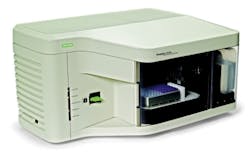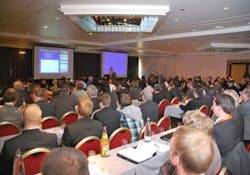Laser Additive Manufacturing Workshop a success
Paul Denney
Laser additive manufacturing has finally become a process of interest for a number of industries
The term “laser additive manufacturing” covers a wide range of processes. It can range from depositing a “patch” on a damaged or worn steel part to the fabrication of functional micron-scale parts in exotic materials for medical applications. Having been involved in laser “additive manufacturing” for over 25 years, I find it somewhat humorous that today’s design and sustainment problems have finally caught up with this “new” solution. While there have always been proponents of the technology for niche applications, with recent improvements in lasers, digital modeling and control, and re-thinking by companies with respect to “repair” versus “replace,” additive manufacturing has finally become a process of interest for a number of industries. As designs and cost reduction efforts push manufacturers and operators, it is probable that laser additive manufacturing will become even more broadly used.
The Laser Institute of America (LIA) held its second Laser Additive Manufacturing (LAM) workshop in Houston, TX, on May 11 and 12, 2010. Designed to gather those involved in the wide areas of laser deposition of materials, this workshop drew 50% more attendees than last year’s inaugural event, including representatives from more than 11 countries. The participants held interests ranging from the use of lasers to repair/refurbish components to “digital” fabrication of functional components.
The LAM workshop began in 2009, when it was noted that a noticeable percentage of papers appearing at ICALEO were focused on the use of lasers to deposit materials. Unlike ICALEO, which has multiple tracks over four days and is more academic in nature, the LAM workshop had the objective of being more application-oriented with participation by those that use or would like to use the technology.
LAM was launched March 3-4, 2009 in San Antonio, TX, a location selected because of the number of facilities located in Texas involved with laser cladding for the oil/gas/energy industries (FIGURE 1). There were a number of concerns about starting a new conference/workshop during what many considered to be the worst economic environment since the Great Depression. However, the workshop was well attended, suggesting that the topic was timely even in a down economy.
The LIA was very pleased with the 2010 LAM, which grew 47% versus 2009. This may be attributed to the workshop developers emphasizing their commitment to providing both end users and manufacturers with the practical knowledge and information needed to use lasers productively and profitably (FIGURE 2).
Keynote speaker Dr. William “Bill” Steen of Liverpool University, Liverpool, U.K., commented that LAM was well organized with an extraordinary level of friendliness among the participants who were highly motivated to move their businesses forward. Dr. Steen said, “Regarding the technology, significant advances have been made in developing high efficiency and high quality cladding, with tentative adventures into 3D manufacture. This is obviously a subject that is growing and will become a large industry.”
Dr. Ingomar Kelbassa of RWTH Aachen University, Germany, remarked that “this year’s LAM workshop is the one and only workshop/conference I know which is absolutely focused on processes such as LMD [laser metal deposition] and SLM [selective laser melting]. LAM is industry driven, and the main forum for experience exchange in that specific field of application.”
The Plenary chair, Dr. Jim Sears of the South Dakota School of Mines & Technology, arranged three speakers. Dr. Steen gave the first one, an overview of the technology. Steen has been involved in laser materials processing for almost five decades. His presentation was titled “Some Thoughts on Laser Additive Manufacturing”. Dr. Steen mentioned that while laser cladding had been around for a long time, advances such as low cost and easy-to-operate computers are making precision manufacturing possible and economical.
A second presentation by Dr. Kelbassa, titled “Additive Manufacturing, Repair and Salvage of High-Value Aero-Engine Components by Laser Metal Deposition and Selective Laser Melting,” reviewed a number of advances that have been made in Europe in aerospace such as the repair of blade integrated disks (BLISKS) and nozzle vanes (NGVs), which are important components in today’s advanced jet engines.
The final plenary presentation was by Dave Abbott of General Electric Aviation, who focused on progress being made in the establishment of standards for additive manufacturing especially through the ASTM F-42 committee. This committee, created to standardize various aspects of additive manufacturing, has begun with creating definitions so that people can communicate with common meanings for terms that may be used in additive manufacturing.
An additional 20 papers were presented, ranging from materials used for deposition to the types of lasers and optics used for additive manufacturing to examples from various industries that are using LAM. The material presentations included presentations by powder manufacturers such as North American Hoganas and presentations by Alabama Laser (Wayne Penn) (FIGURES 3 and 4) and Preco (Joel DeKock), who both use wire as the additive material. Presentations on laser and optics systems included dedicated equipment for inside bore cladding by Paul Colby of Xaloy and laser processing heads for cladding and heat treatment from Scott Heckert of II-VI. On the second day, there were a number of presentations that related to specific applications. Dr. Sears presented on work he has accomplished on “scaffolding” for bone growth into prosthetics. Dr. Rich Martukanitz presented on a number of Navy applications for laser cladding/repair.
“The LAM is the only venue dedicated solely to additive or direct manufacturing,” stated Dave Hudson, president of Joining Technologies (FIGURE 5). “As such it brings together an interested group of competitors and educators to enthusiastically discuss advances in the field. Any potential user of the technology needs only to sit and listen in order to gain insight collected over decades by the world’s leaders in additive manufacturing. Joining Technologies is proud to be a member of this group and will continue in its efforts to advance the technology by their continued sponsorship of LAM.”
FIGURE 5. Example of surface cladding of component face. Courtesy: Joining Technologies
In addition to the technical presentations, 22 exhibitors were present, including laser manufacturers, integrators, research organizations, laser cladding service providers, and powder manufacturers. There were also 13 sponsors that made the workshop possible and a success. With the success of LAM 2010, the LIA staff has already begun to plan for LAM 2011, which will be held early next year.
Paul Denney is director of the Laser Applications Laboratory at the Connecticut Center for Advanced Technology. He can be reached at [email protected].



